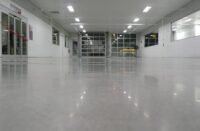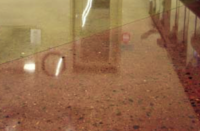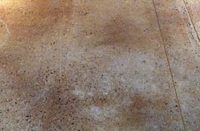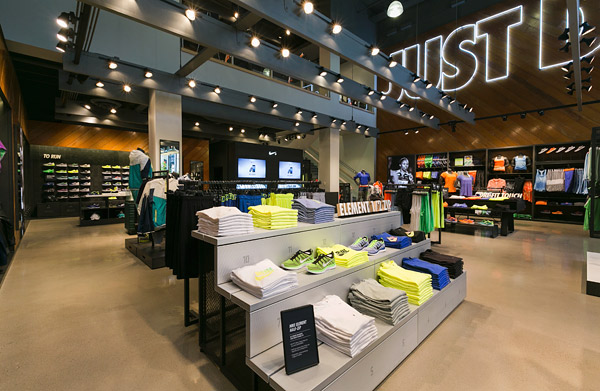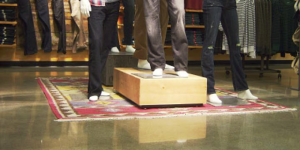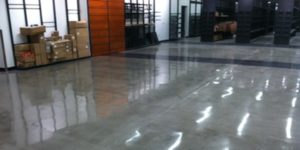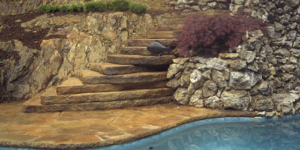It’s all about branding with the big-name consumer retail companies these days, and Nike is one of the biggest brand names around.
At the new Nike Running store at The Grove in Los Angeles, a polished concrete overlay was chosen to help produce the brand impression sought by Nike and architect McCall Design Group of San Francisco. They handed the ball to Mark Beamish Waterproofing (MBW), Anaheim, California, to execute the game plan: installation of a cement-based overlay from Raeco Inc. with a custom aggregate mix, followed by diamond polishing.
The playbook dictated a fast-moving formation, with no margin for error and the time clock ticking, to meet the demand of quick turnaround and a flawless, seamless floor. The location — an upscale shopping venue just south of Hollywood — and the demanding schedule required precision planning and execution to mix and install 70 to 80 batches of Raeco’s SLT HS, a self-leveling, structural-grade floor-topping mortar touted as producing a very hard, durable surface.
“A key was the training,” says Chris Lott, MBW project manager. “We’ve done the Raeco material before in this kind of installation, but not with this variation in aggregate. We took a lot of video of the sample process and passed it along to the foreman. We walked through everything, mentally practiced everything, and the foreman knew what it was going to take.
“They had the right measurement containers from Raeco, and that was a key. This kind of job starts slow, but when they got into a rhythm they knocked it out.”
The look of a field house
The owners of the Nike store sought to produce a field-house vibe with the design of the store, says Dennis Wu, project architect for McCall Design Group.
“The goal was to specify a flooring material that could provide a backdrop for the bleacher-wood wall finish,” Wu says. The flooring material also needed to be consistent in texture and “simple yet impactful,” he says. Last but not least, it had to work when installed over an old floor.
Lott says the 3,000-square-foot flooring install presented logistical challenges for MBW, as the shopping mall is pedestrian-oriented, with streets that are closed to motor traffic in evenings.
Then there was the messy existing flooring — residual tile, plus plywood and concrete where tile had been removed. In preparation for overlay, metal lath was installed over the plywood, the concrete was shotblasted and the tile was cleaned.
A primer, Raeco’s R-2000 latex bonding agent, was applied by paint roller to all the surfaces. This is allowed to cure to a tacky level, then the self-leveling overlay is installed, Lott says.
Allowing enough cure time prior to diamond grinding is important. “You want to grind in a timely fashion,” Lott says. The optimal time is 15 to 18 hours after application of overlay, he says.
A key to the installation was incorporation of aggregate — in this case dark-colored pebbles of 1/4- to 3/8-inch size. Nike insisted on a certain level of aggregate exposure to give a salt-and-pepper appearance. At the same time, aggregate concentration was not completely uniform. To get the variation sought by the owner, MBW used twice as much aggregate in every fourth or fifth batch mixed.
Under the microscope
Nike representatives put MBW through the paces in developing samples of approximately 3 feet square, Lott says. The samples were given the complete polishing treatment, including edge work with hand-held grinders.
The diamond grinding and polishing process achieved a level 2 polish, starting with an initial grind using 60- to 80-grit metal-bond diamonds, followed by subsequent passes with 100-grit hybrid and 200- and 400-grit resin diamonds. For densification, Raeco’s sodium silicate densifier was applied. MBW also applied a clear sealer, Convergent Concrete Technology’s Pentra-Guard (EXT), a lithium-fortified product. A high-speed burnish was a final step.
A special decorative element was added at the front-door entrance, where MBW shotblasted “1979” into the overlay surface, a reference to the year of a major Nike milestone — introduction of its Air shoe technology. For this process, MBW used a stencil based on a layout from Nike. The entryway surface was given one grind step with 100-grit resin-bond diamonds. Densifier was used, but subsequent polishing passes were omitted. A man in the Los Angeles area supplied the stencil, but Lott can’t remember his name.
Dash to the finish
For its efforts, Mark Beamish Waterproofing won first place this year at the American Association of Concrete Contractors’ Decorative Concrete Council (DCC) awards competition, in the Polished Concrete category.
MBW went into sprint mode to ensure a winning result on the Nike store project, the company says. Logistics presented the primary challenge, as the overlay material sets quickly, demanding a “flawless first-time application,” the company said in its submission to the DCC awards program.
The specification of a seamless floor added the requirement of a one-night, nonstop installation plan. The company devised a process where three crew members mixed the overlay and aggregate material while three others poured and two worked to level the overlay. One additional crew member trailed behind, smoothing out the final finish. Prep work was done in a morning, install was done in one night, and grinding was completed over a four-night period.
Key players on the job included foremen Ramon Zavalza, who supervised the overlay pour, and Jose Tovar, quarterbacking the polishing program. Lott calls Zavalza “one of the best in the country with overlays” and says Tovar possesses “world-class skill” in the concrete polishing field. “Together, they know what it’s going to take, what looks good and how to make things right.”
McCall Design Group’s Wu says the overlay delivered “a consistent texture in terms of sand-to-aggregate ratio. Through polishing, the topping achieved a subtle level of reflectiveness. When the wall was cladded with refinished bleacher wood, the floor juxtaposed and amplified the natural warmth in the wood and further enhanced the field-house design concept.”
When the client floated the field-house idea, Wu says the designers worked closely with MBW to develop a control sample that achieved the right amount of texture, reflectiveness and color. As construction began, MBW developed a fixed-size mock-up on the premises so it could be reviewed in exterior and interior lighting conditions for reflectiveness and color before final installation.
Wu says McCall Design Group is satisfied that the flooring choice and material echo the overall design intent, and gives MBW points for an installation that was “effective and efficient.”
Project at a Glance
Client: Nike Running at The Grove (retail store owned and operated by Nike Inc.), Los Angeles
Decorative concrete contractor: Mark Beamish Waterproofing (MBW) Inc., Anaheim, California | www.markbeamish.com
Architect: McCall Design Group, San Francisco; Dennis Wu, project manager | www.mccalldesign.com
General contractor: David Nice Builders, Los Angeles | www.davidnicebuilders.com
Designer: Nike Inc., Beaverton, Oregon; Tim Rupp, lead designer
Project manager: Nike Inc.; Jen Gagner, project construction manager
Scope of project: Installation of cementitious overlay on existing concrete, tile and plywood flooring surface, including custom decorative aggregate; densification and polishing of overlay
Project duration: 7 days
Most challenging aspects: Accelerated project schedule for retail location in upscale shopping venue; achieving aggregate exposure and variation in aggregate distribution specified by owner; coordination and execution of one-time overlay installation to facilitate seamlessness in flooring surface
Products used: Raeco SLT HS self-leveling, structural-grade floor-topping overlay with decorative aggregate; Raeco R-2000 latex bonding agent; Raeco densifier; Convergent Concrete Technology Pentra-Guard (EXT) sealer
